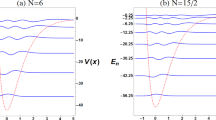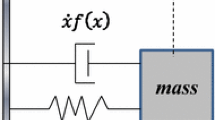Summary
Exact expressions have been obtained for the frequency of an anharmonic oscillator, the shift in its equilibrium position from the origin and for the amplitudes of its different harmonics. It is shown that the frequency of the oscillator is a decreasing function of the energy and that some of the results of wave-mechanics can be obtained from the classical theory by substituting in the classical energy of the oscillator the different energy values of a harmonic oscillator. The eigenvalues of the oscillator are determined by using the W.K.B. method. The classical theory of a Morse oscillator has similarly been worked out in Appendix II.
Similar content being viewed by others
References
Lord RayleighTheory of Sound, 1948, pp. 76–78.
Herzberg, G.Spectra of Diatomic Molecules, Second Edition, pp. 90–102.
Fermi, E.Moleküle und Kristalle, p. 140.
Magnus, W. and OberhettingerFormulas and Theorems for the Special Functions of Mathematical Physics, 1949, 108.
Whittaker and WatsonModern Analysis, Fourth Edition (Chapters XXI and XXII).
Ta-You-WuVibrational Spectra and Structure of Polyatomic Molecules, 1939, 48.
Langer, R.E.Phys. Rev., 1937,51, 669.
Morse, P. M. —, 1929,34, 57.
Author information
Authors and Affiliations
Rights and permissions
About this article
Cite this article
Viswanathan, K.S. The theory of the anharmonic oscillator. Proc. Indian Acad. Sci. 46, 203–217 (1957). https://doi.org/10.1007/BF03045969
Received:
Issue Date:
DOI: https://doi.org/10.1007/BF03045969




